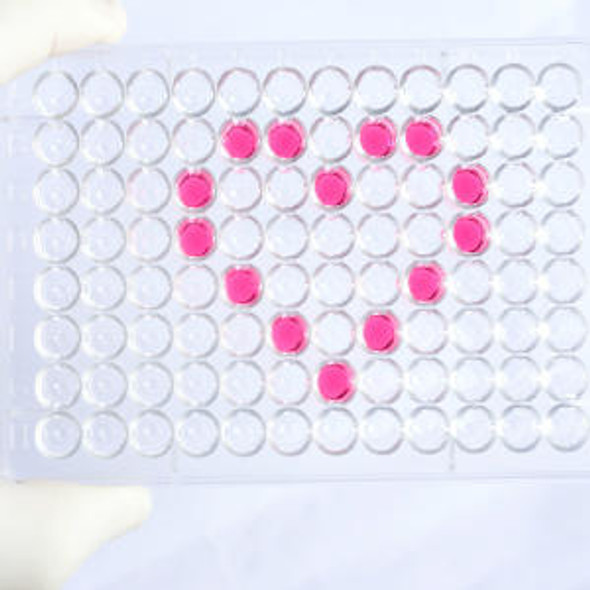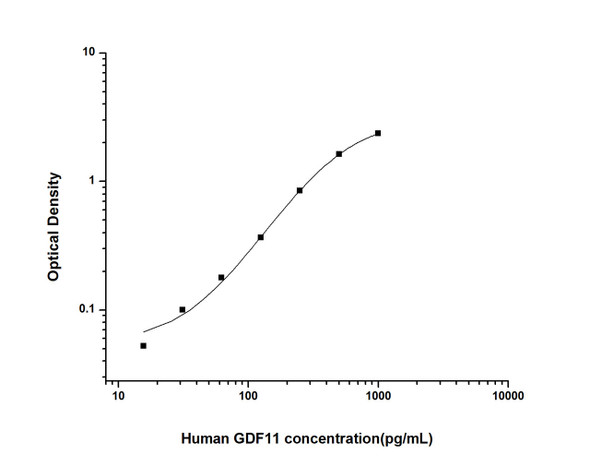Human Immunology ELISA Kits 12
Human GDF11 (Growth Differentiation Factor 11) CLIA Kit (HUES01053)
- SKU:
- HUES01053
- Product Type:
- ELISA Kit
- ELISA Type:
- CLIA Kit
- Size:
- 96 Assays
- Sensitivity:
- 4.69pg/mL
- Range:
- 7.81-500pg/mL
- ELISA Type:
- Sandwich
- Reactivity:
- Human
- Sample Type:
- Serum, plasma and other biological fluids
Description
| Assay type: | Sandwich |
| Format: | 96T |
| Assay time: | 4.5h |
| Reactivity: | Human |
| Detection method: | Chemiluminescence |
| Detection range: | 7.81-500 pg/mL |
| Sensitivity: | 4.69 pg/mL |
| Sample volume: | 100µL |
| Sample type: | Serum, plasma and other biological fluids |
| Repeatability: | CV < 15% |
| Specificity: | This kit recognizes Human GDF11 in samples. No significant cross-reactivity or interference between Human GDF11 and analogues was observed. |
This kit uses Sandwich-CLIA as the method. The micro CLIA plate provided in this kit has been pre-coated with an antibody specific to Human GDF11. Standards or samples are added to the appropriate micro CLIA plate wells and combined with the specific antibody. Then a biotinylated detection antibody specific for Human GDF11 and Avidin-Horseradish Peroxidase (HRP) conjugate are added to each micro plate well successively and incubated. Free components are washed away. The substrate solution is added to each well. Only those wells that contain Human GDF11, biotinylated detection antibody and Avidin-HRP conjugate will appear fluorescence. The Relative light unit (RLU) value is measured spectrophotometrically by the Chemiluminescence immunoassay analyzer. The RLU value is positively associated with the concentration of Human GDF11. The concentration of Human GDF11 in the samples can be calculated by comparing the RLU of the samples to the standard curve.
| UniProt Protein Function: | GDF11: Secreted signal that acts globally to specify positional identity along the anterior/posterior axis during development. Play critical roles in patterning both mesodermal and neural tissues and in establishing the skeletal pattern. Belongs to the TGF-beta family. |
| UniProt Protein Details: | Protein type:Secreted, signal peptide; Secreted Chromosomal Location of Human Ortholog: 12q13. 2 Cellular Component: extracellular space; intracellular membrane-bound organelle; nucleoplasm; protein complex Molecular Function:cytokine activity; growth factor activity; transforming growth factor beta receptor binding Biological Process: camera-type eye morphogenesis; cell development; cell maturation; growth; mesoderm development; metanephros development; negative regulation of cell proliferation; negative regulation of neuron differentiation; nervous system development; palate development; pancreas development; regulation of apoptosis; regulation of MAPKKK cascade; skeletal development; spinal cord anterior/posterior patterning; ureteric bud development |
| NCBI Summary: | The protein encoded by this gene is a member of the bone morphogenetic protein (BMP) family and the TGF-beta superfamily. This group of proteins is characterized by a polybasic proteolytic processing site which is cleaved to produce a mature protein containing seven conserved cysteine residues. The members of this family are regulators of cell growth and differentiation in both embryonic and adult tissues. Studies in mice and Xenopus suggest that this protein is involved in mesodermal formation and neurogenesis during embryonic development. [provided by RefSeq, Jul 2008] |
| UniProt Code: | O95390 |
| NCBI GenInfo Identifier: | 12643335 |
| NCBI Gene ID: | 10220 |
| NCBI Accession: | O95390. 1 |
| UniProt Secondary Accession: | O95390,Q9UID1, Q9UID2, |
| UniProt Related Accession: | O95390 |
| Molecular Weight: | 45,091 Da |
| NCBI Full Name: | Growth/differentiation factor 11 |
| NCBI Synonym Full Names: | growth differentiation factor 11 |
| NCBI Official Symbol: | GDF11 |
| NCBI Official Synonym Symbols: | BMP11; BMP-11 |
| NCBI Protein Information: | growth/differentiation factor 11 |
| UniProt Protein Name: | Growth/differentiation factor 11 |
| UniProt Synonym Protein Names: | Bone morphogenetic protein 11; BMP-11 |
| UniProt Gene Name: | GDF11 |
| UniProt Entry Name: | GDF11_HUMAN |
As the RLU values of the standard curve may vary according to the conditions of the actual assay performance (e. g. operator, pipetting technique, washing technique or temperature effects), the operator should establish a standard curve for each test. Typical standard curve and data is provided below for reference only.
| Concentration (pg/mL) | RLU | Average | Corrected |
| 500 | 47562 55512 | 51537 | 51508 |
| 250 | 20257 21739 | 20998 | 20969 |
| 125 | 9582 9210 | 9396 | 9367 |
| 62.5 | 4378 4646 | 4512 | 4483 |
| 31.25 | 2322 2276 | 2299 | 2270 |
| 15.63 | 1281 1219 | 1250 | 1221 |
| 7.81 | 732 748 | 740 | 711 |
| 0 | 29 29 | 29 | -- |
Precision
Intra-assay Precision (Precision within an assay): 3 samples with low, mid range and high level Human GDF11 were tested 20 times on one plate, respectively.
Inter-assay Precision (Precision between assays): 3 samples with low, mid range and high level Human GDF11 were tested on 3 different plates, 20 replicates in each plate.
| Intra-assay Precision | Inter-assay Precision | |||||
| Sample | 1 | 2 | 3 | 1 | 2 | 3 |
| n | 20 | 20 | 20 | 20 | 20 | 20 |
| Mean (pg/mL) | 26.25 | 45.85 | 228.71 | 25.83 | 41.89 | 226.12 |
| Standard deviation | 2.70 | 4.65 | 23.49 | 2.24 | 4.71 | 23.92 |
| C V (%) | 10.29 | 10.14 | 10.27 | 8.67 | 11.24 | 10.58 |
Recovery
The recovery of Human GDF11 spiked at three different levels in samples throughout the range of the assay was evaluated in various matrices.
| Sample Type | Range (%) | Average Recovery (%) |
| Serum (n=5) | 85-99 | 90 |
| EDTA plasma (n=5) | 101-113 | 107 |
| Cell culture media (n=5) | 87-99 | 93 |
Linearity
Samples were spiked with high concentrations of Human GDF11 and diluted with Reference Standard & Sample Diluent to produce samples with values within the range of the assay.
| Serum (n=5) | EDTA plasma (n=5) | Cell culture media (n=5) | ||
| 1:2 | Range (%) | 98-112 | 95-108 | 94-108 |
| Average (%) | 104 | 101 | 102 | |
| 1:4 | Range (%) | 98-112 | 94-112 | 101-118 |
| Average (%) | 104 | 102 | 110 | |
| 1:8 | Range (%) | 101-114 | 91-105 | 88-102 |
| Average (%) | 107 | 98 | 96 | |
| 1:16 | Range (%) | 86-100 | 88-100 | 90-103 |
| Average (%) | 92 | 95 | 97 |
An unopened kit can be stored at 4°C for 1 month. If the kit is not used within 1 month, store the items separately according to the following conditions once the kit is received.
| Item | Specifications | Storage |
| Micro CLIA Plate(Dismountable) | 8 wells ×12 strips | -20°C, 6 months |
| Reference Standard | 2 vials | |
| Concentrated Biotinylated Detection Ab (100×) | 1 vial, 120 µL | |
| Concentrated HRP Conjugate (100×) | 1 vial, 120 µL | -20°C(shading light), 6 months |
| Reference Standard & Sample Diluent | 1 vial, 20 mL | 4°C, 6 months |
| Biotinylated Detection Ab Diluent | 1 vial, 14 mL | |
| HRP Conjugate Diluent | 1 vial, 14 mL | |
| Concentrated Wash Buffer (25×) | 1 vial, 30 mL | |
| Substrate Reagent A | 1 vial, 5 mL | 4°C (shading light) |
| Substrate Reagent B | 1 vial, 5 mL | 4°C (shading light) |
| Plate Sealer | 5 pieces | |
| Product Description | 1 copy | |
| Certificate of Analysis | 1 copy |
- Set standard, test sample and control (zero) wells on the pre-coated plate and record theirpositions. It is recommended to measure each standard and sample in duplicate. Note: addall solutions to the bottom of the plate wells while avoiding contact with the well walls. Ensuresolutions do not foam when adding to the wells.
- Aliquot 100 µL of standard solutions into the standard wells.
- Add 100 µL of Sample / Standard dilution buffer into the control (zero) well.
- Add 100 µL of properly diluted sample (serum, plasma, tissue homogenates and otherbiological fluids. ) into test sample wells.
- Cover the plate with the sealer provided in the kit and incubate for 90 min at 37 °C.
- Aspirate the liquid from each well, do not wash. Immediately add 100 µL of BiotinylatedDetection Ab working solution to each well. Cover the plate with a plate seal and gently mix. Incubate for 1 hour at 37 °C.
- Aspirate or decant the solution from the plate and add 350 µL of wash buffer to each welland incubate for 1-2 minutes at room temperature. Aspirate the solution from each well andclap the plate on absorbent filter paper to dry. Repeat this process 3 times. Note: a microplatewasher can be used in this step and other wash steps.
- Add 100 µL of HRP Conjugate working solution to each well. Cover with a plate seal andincubate for 30 min at 37 °C.
- Aspirate or decant the solution from each well. Repeat the wash process for five times asconducted in step 7.
- Add 100 µL of Substrate mixture solution to each well. Cover with a new plate seal andincubate for no more than 5 min at 37 °C. Protect the plate from light.
- Determine the RLU value of each well immediately.






